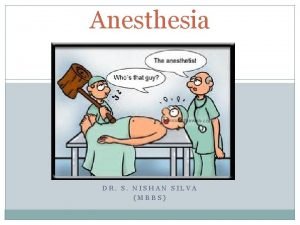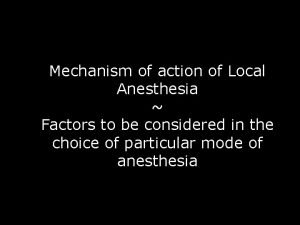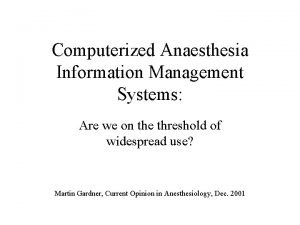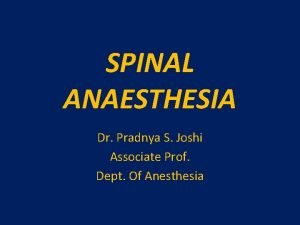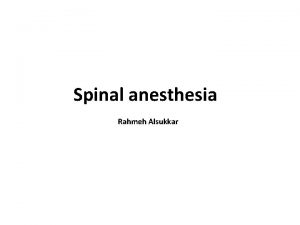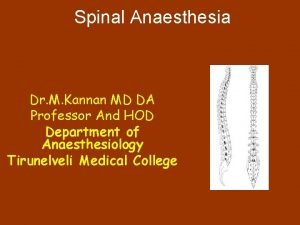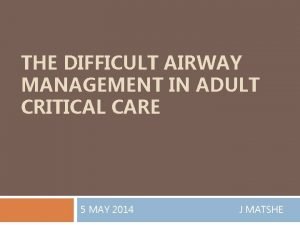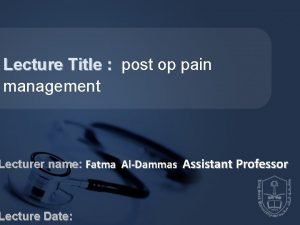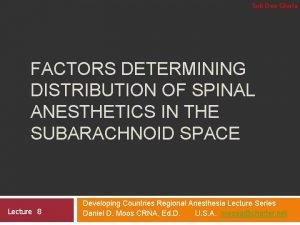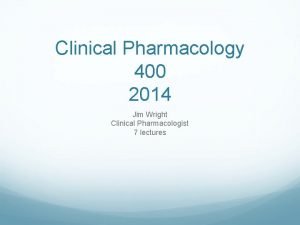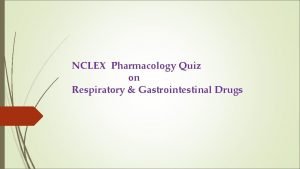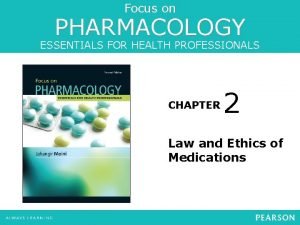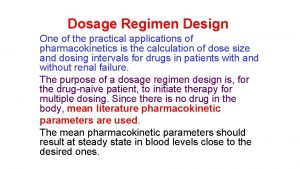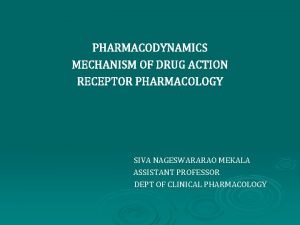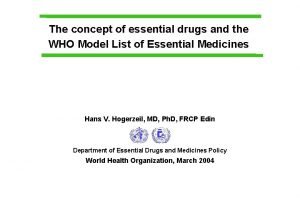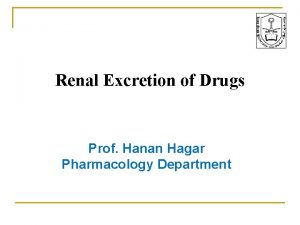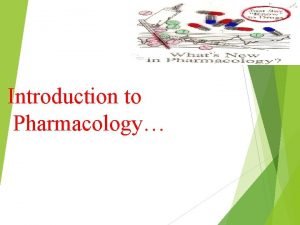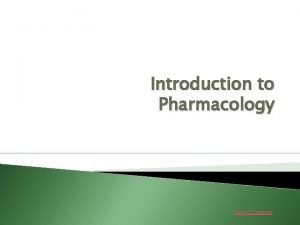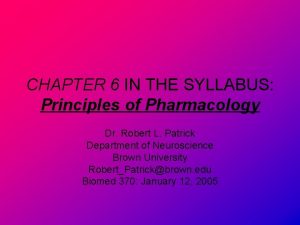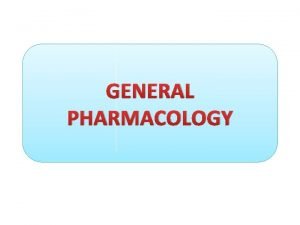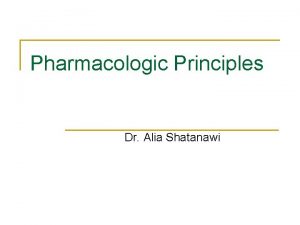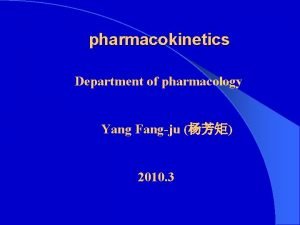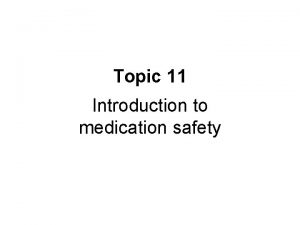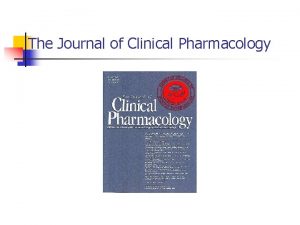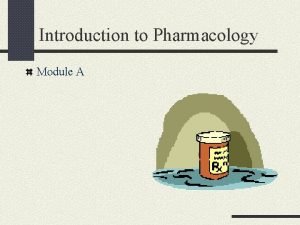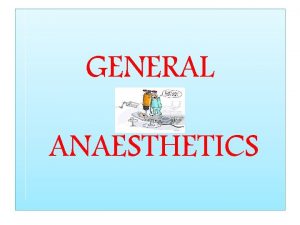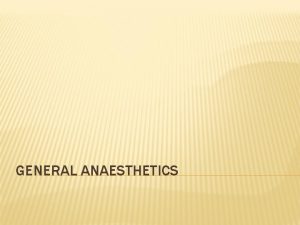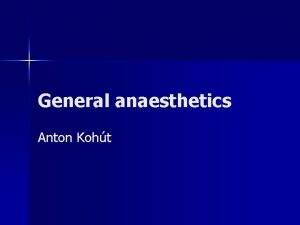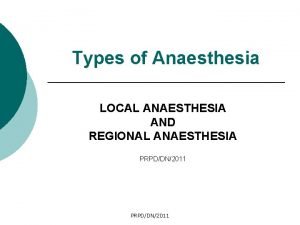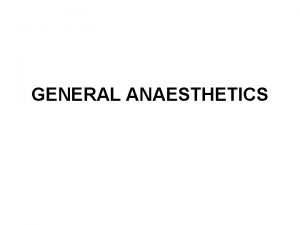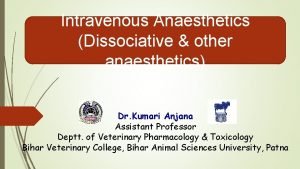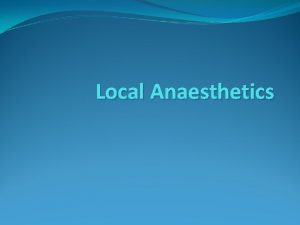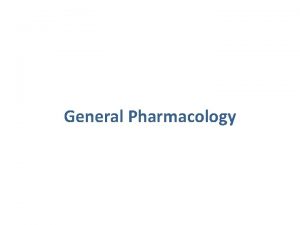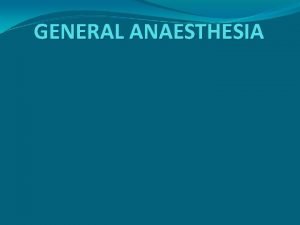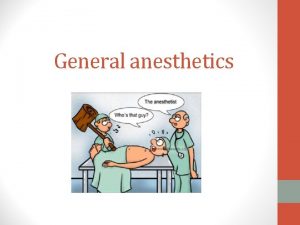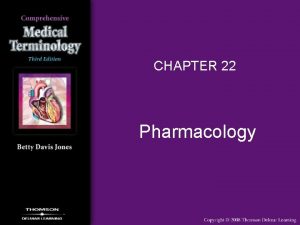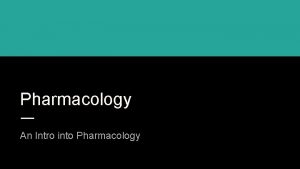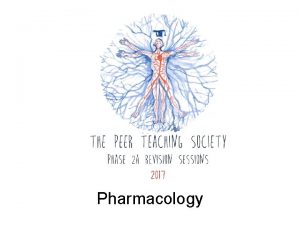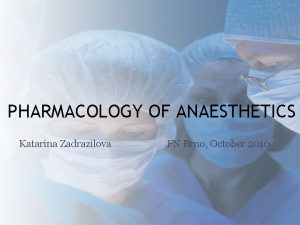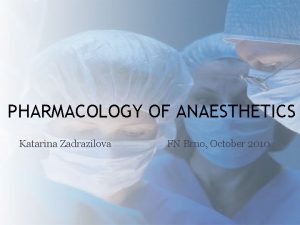Pharmacology of General Anaesthetics GA Anaesthesia is a

































- Slides: 33

Pharmacology of General Anaesthetics (GA)

• Anaesthesia – is a reversible condition of comfort and quiescence for a patient within the physiological limit before, during and after performance of a procedure. • General anaesthesia – for surgical procedure to render the patient unaware/unresponsive to the painful stimuli. – Drugs producing General Anaesthesia – are called General Anaesthetics

• General Anaesthetics are the drugs which produce reversible loss of all modalities of sensation and consciousness, or simply, a drug that brings about a reversible loss of consciousness. • Remember !!! These drugs are generally administered by an anaesthesiologist in order to induce or maintain general anaesthesia to facilitate surgery. • General anaesthetics are – mainly inhalation or intravenous. • Balanced Anaesthesia: A combination of IV anaesthetics and inhaled anaesthetics.

Essential components of GA • Cardinal Features: 1. Loss of all modalities of sensations • 2. Sleep and Amnesia • 3. Immobility or Muscle relaxation • 4. Abolition of reflexes – somatic and autonomic

Anaesthesia events Practically • 1. Induction: It is the period of time which begins with the administration of an anaesthetic upto the development of Surgical anaesthesia. Done by inducing agents – Thiopentone sodium. • 2. Maintenance: Sustaining the state of anaesthesia. Done by Inhalation agents – Nitrous oxide and halogenated hydrocarbons. • 3. Recovery: Anaesthetics stopped at the end of surgical procedure and consciousness regains

(Classification) • Inhalation: 1. Gas: Nitrous Oxide • Volatile liquids: Ether • Halothane • Enflurane • Isoflurane • Desflurane • Sevoflurane • Intravenous: 1. Inducing agents: • Thiopentone, Methohexitone sodium, propofol and etomidate 1. Benzodiazepines (slower acting): • Diazepam, Lorazepam, Midazolam 1. Dissociative anaesthesia: • Ketamine 1. Neurolept analgesia: • Fentanyl

Stage I: Stage of Analgesia • Starts from beginning of anaesthetic inhalation and lasts upto the loss of consciousness • Pain is progressively abolished during this stage • Patient remains conscious, can hear and see, and feels a dream like state • Reflexes and respiration remain normal • It is difficult to maintain - use is limited to short procedures only

Stage II: Stage of Delirium and Excitement: • From loss of consciousness to beginning of regular respiration • Excitement - patient may shout, struggle and hold his breath • Muscle tone increases, jaws are tightly closed. • Breathing is jerky; vomiting may occur. • Heart rate and BP may rise and pupils dilate due to sympathetic stimulation. • No stimulus or operative procedure carried out during this stage. • Breath holding is commonly seen. Potentially dangerous responses can occur during this stage including vomiting, laryngospasm and uncontrolled movement.

Stage III: Stage of Surgical anaesthesia • Extends from onset of regular respiration to cessation of spontaneous breathing. This has been divided into 4 planes: – Plane 1: Roving eye balls. This plane ends when eyes become fixed. • Plane 2: Loss of corneal and laryngeal reflexes. • Plane 3: Pupil starts dilating and light reflex is lost. • Plane 4: Intercostal paralysis, shallow abdominal respiration, dilated pupil.

Stage IV: Medullary / respiratory paralysis • Cessation of breathing failure of circulation death • Pupils: widely dilated • Muscles are totally flabby • Pulse is imperceptible • BP is very low.

Properties of GA • For Patient: - Pleasant, non-irritating and should not cause nausea or vomiting Induction and recovery should be fast • For Surgeon: - analgesia, immobility and muscle relaxation - nonexplosive and noninflammable

• For the anaesthetist: Margin of safety: No fall in BP • Heart, liver and other organs: No affect • Potent , Cheap, stable and easily stored • Should not react with rubber tubing or soda lime. Rapid adjustment of depth of anaesthesia should be possible

1. Diethyl ether • Colourless, highly volatile liquid with a pungent odour. Boiling point = 35ºC. • Produces irritating vapours and are inflammable and explosive. • Pharmacokinetics: - 85 to 90 percent is eliminated through lung and remainder through skin, urine, milk and sweat - Can cross the placental barrier

• Advantages - Can be used without complicated apparatus Potent anaesthetic and good analgesic - Muscle relaxation - Wide safety of margin - Respiratory stimulation and bronchodilatation. No cardiac arrythmias - Can be used in delivery - Less likely hepato or nephrotoxicity Disadvantages Inflammable and explosive Slow induction and unpleasant - Struggling, breath holding, salivation and secretions (drowning) atropine - Slow recovery – nausea & vomiting - Cardiac arrest - Convulsion in children -

Nitrous oxide/laughing gas • Colourless, odourless inorganic gas with sweet taste • Noninflammable and nonirritating, but of low potency • Very potent analgesic, but not potent anaesthetic • Carrier and adjuvant to other anaesthetics • As a single agent used wit O 2 in dental extraction and in obstetrics

Nitrous oxide • Advantages: - Noninflammable and nonirritant - Rapid induction and recovery - Very potent analgesic (low concentration) - No effect on heart rate and respiration – mixture advantage - No nausea and vomiting – • Disadvantages: – Not potent alone (supplementation) – Not good muscle relaxant, unconsciousness cannot be produced without hypoxia – Inhibits methionine synthetase (precursor to DNA synthesis) – Inhibits vitamin B-12 metabolism – Dentists, OR personnel, abusers at risk – Gas filled spaces expansion (pneumothorax) dangerous

Halothane • Fluorinated volatile liquid with sweet odour, non-irritant non-inflammable • Potent anaesthetic (if precise control), 2 -4% for induction and 0. 5 -1% for maintenance • Boiling point - 50ºC • Pharmacokinetics: 60 to 80% eliminated unchanged. 20% retained in body for 24 hours and metabolized • Delivered by the use of a special vapourizer • Not good analgesic or relaxants

• Advantages: - Noninflammable and nonirritant - Abolition of Pharyngeal and laryngeal reflexes – bronchodilatation – preferred in asthmatics Potent and speedy induction & recovery Controlled hypotension Inhibits intestinal and uterine contractions • Disadvantages: - Special apparatus - vapourizer Poor analgesic and muscle relaxation - Myocardial depression –– reduced cardiac output Hypotension –Heart rate – reduced - Arrythmia - Respiratory depression –Decreased urine formation – due to decreased gfr Malignant hyperthermia: Prolongs labour

Enflurane • Non-inflammable, with mild sweet odour and boils at 57ºC • Similar to halothane in action, except better muscular relaxation • Depresses myocardial force of contraction and sensitize heart to adrenaline • Induces seizure in deep anaesthesia and therefore not used now

Isoflurane • Isomer of enflurane and have similar properties but slightly more potent. Induction dose is 1. 5 – 3% and maintenance dose is 1 – 2% • Rapid induction (7 -10 min) and recovery by special vapourizer.

Isoflurane • • • Advantages: - Rapid induction and recovery - Good muscle relaxation - Good coronary vasodilatation - CO maintained, HR increased – beta receptor stimulation - Less Myocardial depression - No renal or hepatotoxicity Low nausea and vomiting - No dilatation of pupil and no loss of light reflex in deep anaesthesia - No seizure and preferred in neurosurgery • • • Disadvantages: - Pungent and respiratory irritant - Special apparatus required - Respiratory depression – prominent - Maintenance only, no induction - Hypotension - ß adrenergic receptor stimulation - Costly

Intravenous Anaesthetics • For induction only • • Inducing agents: Rapid induction (one arm. Thiopentone, brain circulation time) • Methohexitone sodium, For maintenance not used propofol and etomidate – • Alone – supplemented Benzodiazepines (slower with analgesic and acting): Diazepam, muscle relaxants Lorazepam, Midazolam • Dissociative anaesthesia: Ketamine • Neurolept analgesia: Fentanyl

Thiopentone sodium Barbiturate: Ultra short acting – Water soluble – Alkaline – Dose-dependent suppression of CNS activity – Dose: 3 -5 mg/kg iv (2. 5%) solution – 15 to 20 seconds • Pharmacokinetics: - Redistribution - Hepatic metabolism (elimination half-life 7 -12 hrs) - CNS depression persists for long (>12 hr)

Side effects • Pre-anaesthetic course – laryngospasm (Atropine and succinylcholine) • Noncompatibility – succinylcholine • Shivering and delirium during recovery • Tissue necrosis--gangrene • Post-anaesthetic course (restlessness) analgesic

• Advantages: - Rapid • Disadvantages: Depth of induction - Does not anaesthesia difficult to sensitize myocardium to judge - Pharyngeal and adrenaline - No nausea laryngeal reflexes persists and vomiting - Non- apnoea – controlled explosive and nonirritant ventilation - Respiratory Short operations (alone) • depression - Hypotension Other uses: convulsion, (rapid) – shock and psychiatric patients and hypovolemia – CVS narcoanalysis of criminals collapse - Poor analgesic – by knocking off guarding and muscle relaxant Gangrene and necrosis Shivering and delirium

Propofol • Replacing thiopentone now – induction and maintenance • Intermittent or continuous infusion – Total IV anaesthesia (supplemented by fentanyl) • Rapid induction: 15 – 45 seconds and lasts for 5– 10 minutes • Rapid distribution – distribution half-life (2 -4 min). Short elimination half-life (100 min) • Propofol is extensively metabolized

• Advantages: - Rapid • Disadvantagesinduction - Does not Induction apnoea (1 sensitize myocardium to min) - Hypotension – adrenaline vasodilatation • - No nausea and • - Bradycardia vomiting - Nonfrequently - Dose explosive and dependent respiratory nonirritant to airways depression • - Total i. v. anaesthesia - • - Pain during injection: Short operations (alone) local anaesthetic in OPDs combination

Ketamine • Dissociative anaesthesia: a state characterized by immobility, amnesia and analgesia with light sleep and feeling of dissociation from ones own body and mind and the surroundings. • Site of action – cortex and subcortical areas – NMDA receptors • Dose: 5 -10 mg/kg im or 1 -2 mg i. v.

Uses • Characteristics of sympathetic nervous system stimulation (increase HR, BP & CO) – hypovolumic shock. In head and neck surgery • In asthmatics – relieves bronchospasm. Short surgical procedures – burn dressing, forceps delivery, breech extraction manual removal of placenta and dentistry • Combination with diazepam - angiography, cardiac catheterization. OPD surgical procedures

Fentanyl • Neurolept analgesia: droperidol , Opioid analgesic • Duration of action: 30 -50 min. Uses: - Supplement in Balanced anaesthesia - In combination with diazepam used in diagnostic, endoscopic and angiographic procedures Adjunct to spinal and nerve block anaesthesia Commanded operation (IV 2 -4 mcg/kg)

• Advantages: - Smooth onset and rapid recovery • - Suppression of vomiting and coughing. Less fall in BP and no sensitization to adrenaline • Disadvantages Respiratory depression (encourage to breathe) - Increase tone of chest muscle (muscle relaxant added to mechanical ventilation) • - Nausea, vomiting and itching during recovery

Preanesthetic medication • Definition: It is the term applied to the use of drugs prior to the administration of an anaesthetic agent to make anaesthesia safer and more agreeable to the patient. • Relief of anxiety Amnesia for pre and post operative events. Analgesia. Decrease secretions. Antiemetic effects. Decrease acidity and volume of gastric juice

• Drugs used: Sedative-anxiolytics – diazepam or lorazepam, midazolam, promethazine etc. Opioids – Morphine and its congeners. Anticholinergics – Atropine H 2 blockers – ranitidine, famotidine etc. • Antiemetics – Metoclopramide, domperidone etc
 Balanced anaesthesia ppt
Balanced anaesthesia ppt Components of anaesthesia
Components of anaesthesia Composition of la
Composition of la Spinal block location
Spinal block location Anaesthesia information management system
Anaesthesia information management system Spinal anaesthesia position
Spinal anaesthesia position Lidocaine max dose
Lidocaine max dose Spinal anesthesia structures pierced
Spinal anesthesia structures pierced Structures pierced in spinal anaesthesia
Structures pierced in spinal anaesthesia 332 rule intubation
332 rule intubation Epidural catheter markings measurement
Epidural catheter markings measurement Inhalation anesthetics
Inhalation anesthetics Lardosis
Lardosis Airway anatomy anesthesia
Airway anatomy anesthesia Clinical pharmacology residency
Clinical pharmacology residency Toxicology and applied pharmacology
Toxicology and applied pharmacology Respiratory pharmacology quiz
Respiratory pharmacology quiz Focus on pharmacology
Focus on pharmacology Maintenance dose equation
Maintenance dose equation Mechanism of drug action
Mechanism of drug action Essential drug concept in pharmacology
Essential drug concept in pharmacology What is ion trapping in pharmacology
What is ion trapping in pharmacology Branches of pharmacology
Branches of pharmacology Pharmacology of drugs acting on respiratory system
Pharmacology of drugs acting on respiratory system Adrenal drugs pharmacology
Adrenal drugs pharmacology Pharmacology introduction
Pharmacology introduction Basic principles of pharmacology
Basic principles of pharmacology Significance of protein binding
Significance of protein binding Alia drug testing
Alia drug testing Estado estable
Estado estable Annual review of pharmacology and toxicology
Annual review of pharmacology and toxicology Rationale meaning in pharmacology
Rationale meaning in pharmacology Clinical pharmacology
Clinical pharmacology Pharmacology module
Pharmacology module

